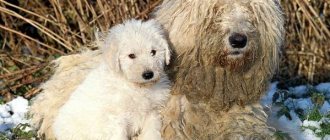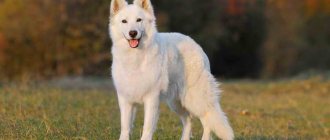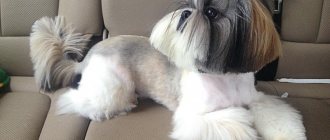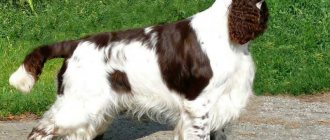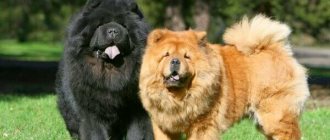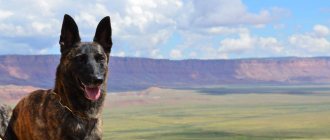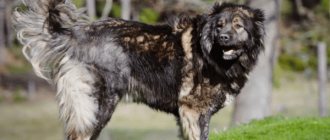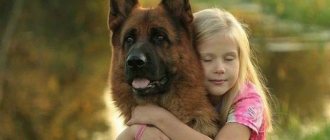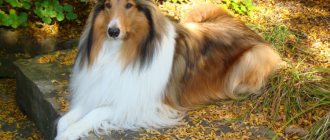| Origin: | Russia, USSR |
| Usage: | universal service dog |
| Color: | black – clean or with tan, black-and-white, zoned with red or gray |
| Dimensions: | 61-70 cm |
| Lifespan: | 12-13 years old |
The East European Shepherd is the most successful breed bred in the Soviet Union. This is a powerful dog, ideal for working in law enforcement agencies. The dog is also an excellent watchman and security guard - he is ready to lay down his life for the safety of his owner.
Interesting Facts
In the short history of the East European Shepherd, curious events occurred:
- According to rumors, VEO's exterior was obtained by mixing the blood of German shepherds, Muscovy dogs, black terriers and huskies. It was rumored that dogs were even crossed with hyenas - supposedly, from them the dogs inherited a powerful grip, strong jaws and a low croup. But these rumors are baseless.
- The exterior of modern VEO is, in fact, a reflection of the standard of the German Shepherd of the 40-50s.
- The first breeding dog of the 30s. Abrek starred in the Soviet film “Gaichi”.
- Soviet cinema fueled interest in the breed. Pictures starring East European shepherds appeared on the screen: “Come to me, Mukhtar”, “True friend Ruslan”, “Give me a paw, Friend”, “Border dog Scarlet”.
- VEO is often called the Western European or Far Eastern Shepherd Dog. But these are the wrong terms.
Origin story
The East European Shepherd (VEO) is a breed whose history began in the 1930s on the territory of the Soviet Union. The breeders planned to create an improved modification of the German Shepherd, large in size and physical strength.
The difference in appearance is too pronounced, and therefore East European Shepherds were identified as a separate breed.
Dog handlers were faced with the task of creating strong and resilient service dogs, adapted to work in all weather conditions. Development began after the end of the First World War, but scientists achieved their greatest success after the Second World War.
Shepherd dogs of the fascist troops, remaining in Soviet shelters, became the ancestors of modern representatives of the Eastern European breed.
Requirements for the VEO standard
The VEO breed standard describes the dog as strong, hardy, and a versatile worker. She is tireless, well adapted to the difficult climate of Russia, and easy to train.
| Parameter | RKF standard dated October 15, 2014 |
| Height | Males 65-70 cm, ideally 63 cm. Females – 61-66 cm, optimal height – 60 cm. |
| East European Shepherd weight | Approximately 35-60 kg for males and 30-50 kg for females. The parameter is not strictly controlled; first of all, the harmony of the addition is assessed. |
| Body type | Strong, muscular, with developed bones and elastic skin. The format is slightly stretched. |
| Frame | The strong neck smoothly flows into the developed withers. The latter is slightly raised above the flat back. The loin is convex and goes into a slightly sloping croup. The chest is deep, oval, the stomach is tucked. |
| Head | Wedge-shaped, large. The rounded forehead goes into an elongated muzzle - they are separated by a faint groove. |
| Nose | Large, black, with wide nostrils. |
| Ears | Medium, stand high, look forward, parallel. The ears are thin, triangular in shape, with sharp tips. |
| Eyes | Slanted, oval shaped. Black for dogs with dark patches on the muzzle, brown for the rest. Dogs of black or light color are allowed soft shades of the iris. |
| Lips | Dry, without jowls, tightly covering the teeth. |
| Bite | Scissor-shaped. |
| Tail | Saber-shaped, long. Abundantly covered with wool, but without fringes or dewlaps. A calm dog keeps its tail lowered, when excited it raises it to the line of the back, and the tip bends to the side or up. |
| Limbs | The front ones are tall, with muscular shoulders and steep, straight forearms. The hindquarters are straight, retracted behind the ischial tuberosities, with sloping shins. |
| Paws | In a lump, oval. Rudimental fingers are docked. |
| Wool | Medium, straight, hard. The undercoat is dense, softer and lighter than the guard hair. The hair on the ears, forehead and paws is shorter than on the back and neck. |
| Color | VEO comes in a zonal color with gray or red inserts, pure black or black and tan, and saddleback color. |
Disqualifying faults
The East European Shepherd is punished or removed from the ring for the following faults and vices:
- inconsistency with the breed type;
- lethargy, causeless aggression, choleric temperament, cowardice;
- deviations in sexual type;
- convex or concave back;
- floppy ears in juniors over 6 months;
- short, curled or kinked tail;
- paws in spread or cat paws;
- snack or undershot;
- cryptorchidism.
A VEO with an incorrect coat structure will also be disqualified:
- long-haired;
- curly;
- without undercoat;
- with white spots on the chest, body or tip of the tail;
- blue, brown or fawn color.
Description of appearance
The dogs of the breed are represented by large-sized individuals: the height measured at the withers varies for males from sixty-five to seventy-five centimeters, for females from sixty-one to seventy-one centimeters. Weight varies from thirty-six to sixty-one kilograms for males and from thirty-one to fifty-one kilograms for females. Although the bones are large, the dogs do not have a coarse body build. Its length exceeds the height at the withers by an average of fifteen centimeters. The muscles are well developed and have a prominent appearance. Gender is easily determined by appearance, since males are much more massive and larger than females.
The head is proportional to the body, quite massive and moderately long, has the appearance of a not particularly pointed wedge, and is located on a muscular, powerful neck. The eyes are almond-shaped, dark, of medium size, set obliquely. Nose with a black nose. The ears are set high, erect, triangular in shape and medium in size.
Photo of an East European Shepherd.
Dogs of this breed have a rather hard, close-fitting coat. The guard hair is medium length, straight. The thighs and forearms are covered with relatively long hair, and the rest with medium length hair. The thick undercoat is well developed, but does not extend beyond the outer coat. Individuals of the breed have the following color: saddleback or black with a dark-colored mask on a light background, the color of which can range from pale gray to fawn. Gray-zoned and red-zoned colors are possible, but not desirable.
For many dog lovers, the East European Shepherd dog is associated with the German Shepherd, and some are sure that they are the same breed. There is some truth to this, since VEOs actually originated from German Shepherds and were bred as a separate breed in the USSR in order to adapt the German Shepherd to the harsh Russian climate.
For many dog lovers, the East European Shepherd dog is associated with the German Shepherd, and some are sure that this is the same breed
The German Shepherd was valued for its unique qualities in many countries of the world, including Russia, but due to the negative attitude of most people towards everything German after the war, the breed had to be renamed and modified several times. Since the Soviet Union was in dire need of hardy service dogs, dog handlers worked hard to develop such a breed.
Psychological picture
The nature of the VEO corresponds to its purpose. These are service dogs created to guard property and protect the owner. That’s why dogs always have their ears on top of their heads – they constantly monitor the territory, looking for potential danger.
VEO is not suitable as a pet. The dog loves work and would prefer to work rather than lie on the couch.
East European Shepherds are unfriendly towards strangers. This does not mean that they rush at the first person they meet. But it’s better not to pet strangers – dogs may interpret the gesture as hostility.
Veo is a suspicious dog. She often sees aggression in ordinary actions. The dog confuses noisy groups with bandits, a friendly pat on the shoulder with blows. The owner must explain the difference. General training courses (GTC), controlled city dog (UGS), and protective guard service (ZKS) will help with this.
Like any service dog breed, VEOs are aimed at obedience. These are well-trained dogs that obey unquestioningly. Moreover, they extremely rarely make their own decisions; before any action they wait for the owner’s order and his approval.
The VEO is more obedient than the German Shepherd. This is due to the temperament of the domestic breed - it is calm, reasonable, and somewhat phlegmatic.
Character
Compared to the German, its eastern relative is much calmer.
The dog tries to be as useful as possible for its owner and does not like strangers. Always ready to protect the owner if necessary.
Children are treated kindly. If a dog grows up with other pets, they will get along well, which cannot be said about street cats.
Note!
Nicknames for dogs for boys - easy, rare and most beautiful names for dogs in alphabetical order
Nicknames for girls' dogs - a list of beautiful, funny, unusual nicknames for large and small dog breeds
Maltipoo dog - everything about the dog from A to Z. Photos, description of the breed, character, maintenance features, prices, reviews
Application of VEO
VEO is a universal service dog. She can handle any discipline, but she is best suited for security, guard, protective and search directions.
The East European Shepherd is used for:
- detection of drugs and explosives;
- defense;
- search and detention of criminals;
- protection of the territory.
Occasionally, VEO is trained as a guide dog. The characteristics of the breed include a balanced, calm temperament, which makes the dogs good caregivers. But in this matter they are superior to Labrador Retrievers.
Things are worse with sports. East European Shepherds are large, heavy, it is difficult for them to take hurdles, they move slower than the same BUT, collie, and Spitz. However, they are trained in canicross, weight-pulling, and agility.
Socialization
East European Shepherds are not the easiest dogs to relate to others. They need to be socialized from the first days of life. Otherwise, behavioral problems, aggression, and unbalanced temperament are inevitable.
If VEO is not trained, her wariness towards strangers and desire to protect her owner will develop into open anger. Bitten neighbors and passers-by are the reality of owners who have left the training of the East European Shepherd to its own devices.
Interaction with a child is easier. The VEO dog does not touch children, but does not respect them either. Children are always lower in rank for her. The pet is not aggressive towards the crumbs, but does not consider them an authority. Entrusting your pet even to a teenager is a bad idea. She will not listen to him and will do as she wants.
Relationships with other pets are different. Males of the East European Shepherd usually quarrel with other males, but they accept females willingly. But cats, rodents and birds are not the best neighbors - they are not given a pass, even if they have lived with them since puppyhood.
Pros and cons of the breed
The existence of the East Siberian Shepherd began to be talked about not so long ago. Where this name came from is written above. It is hardly necessary to repeat myself, since the purpose of the article is to reveal as much as possible the character and description of the East European Shepherd breed.
After reviewing the advantages of its representatives, we can conclude that they have virtually no disadvantages.
This is partly true, but in every barrel of honey there is a fly in the ointment. However, it is worth starting a detailed analysis of the advantages and disadvantages of VEO.
The advantages of the breed include:
- boundless devotion to the owner;
- ideal type of higher nervous activity for work;
- fearlessness;
- loyal attitude towards children, strangers and pets;
- easy learning;
- unpretentiousness in content;
- well developed intellect.
A significant disadvantage of East European Shepherds is their size. Such a dog, with poor obedience, is extremely difficult to keep.
Another disadvantage is the need for constant long walks and mental training.
Training and education of the East European Shepherd
The expression “a dog is a living weapon” suits the East European Shepherd perfectly. They are raising her from a young age - if you miss the moment, VEO will grow into an uncontrollable dog, which not every dog handler can handle.
Owners who previously had “Germans” believe that they can easily raise VEOs. But that's not true. Domestic shepherd dogs are more serious and more capricious than German ones. Before buying a puppy, they will learn everything about the training of the breed, its character - otherwise the owner will be in for an unpleasant surprise.
The opinion that a dog needs to be trained from 6-8 months is wrong. At this age, VEO dogs are already teenagers with their own habits, views on life and remarkable strength. It is sometimes impossible to cope with large “children”.
Therefore, the basics of obedience are laid as soon as the puppy begins to walk. And the first commands are learned from 2-3 months. From 4 months they begin to practice skills from OKD.
VEO psychologically remains a puppy until he is 2 years old. Large, strong, dangerous, but still a puppy. Therefore, classes are kept short and presented in a playful way.
It is impossible to cope with raising a VEO at home if the owner is not an experienced dog handler. Be sure to attend training grounds and professional training.
But only the owner trains the VEO - the help of a dog handler is optional. The East European Shepherd considers the owner to be the one who handles and works with it. A person who only feeds, cares for and walks is simply a service staff for a dog.
Until the age of 1-1.5 years, the European Shepherd undergoes OKD and UGS. But ZKS is indicated only for service dogs. This is harsh discipline. If VEO simply guards the house or is needed to scare away ill-wishers, the course is not required. Under normal conditions, the domestic breed can cope with protecting its owner without special training.
VEO training is simple. Pets, like seeds, click on general course commands and enthusiastically deal with service and sports disciplines. But they are raised day after day all their lives. This is not a breed that, once it has learned a command, always follows it. A week without classes - and a well-trained dog will turn into a spoiled tomboy.
Features of maintenance and care
East European Shepherds are adapted to harsh climates. They tolerate bad weather and frost well. Plus they need a lot of space. Therefore, it is recommended to keep them in a private home.
Some VEOs live in an apartment. But it should be 3-4 rooms and spacious. And the owner is obliged to walk the “urban” shepherd for at least 4 hours a day. But it’s still better to take the dog to a country house.
VEO can be placed in a house or in an enclosure, but not on a chain. Most owners prefer the second option. There is plenty of room for the shepherd dog, and there is no hair, dirt or drool in the room.
The enclosure is equipped with an awning for protection from the sun and a warm booth for cold weather. In winter, the kennel is covered with hay, and in summer, an orthopedic mattress is placed inside - this will prevent the formation of calluses. The sleeping area is cleaned as it gets dirty, and the bedding is changed or washed.
VEO tolerates frost well, but heat - poorly. In summer they eat little and refuse to play. To keep the dog cool, it is recommended to place an old bathtub filled with water on the property.
Grooming
The care and maintenance of VEO is standard and does not take much time. However, they are taught hygiene from puppyhood. Keeping an adult dog who doesn’t like to be brushed or bathed is unrealistic.
They teach it slowly, as if playing veterinarian. When the dog calmly reacts to touches in any part of the body, examination of the ears, eyes and mouth - proceed to hygiene procedures. They are carried out calmly, without scolding or punishment - it is important that the pet associates the manipulations only with pleasant memories.
Caring for an East European Shepherd includes:
- combing 1-2 times a week with a massage brush or rubberized mitten;
- brushing with a slicker brush every day during shedding;
- bathing 1-2 times a month, for dogs living in an enclosure - every 2-3 months;
- weekly cleaning of eyes, ears and teeth;
- inspection of paws after each walk, lubrication with vegetable oils for cracks and abrasions.
VEO's ears go up by six months. Until this age, it is not recommended to stroke their heads - the shells are heavy, large, difficult to stand up, and a careless touch will disrupt the correct formation of cartilage.
Walk
East European Shepherds are active, sporting dogs. They need hours of walks and exercise every day.
Apartment East European Shepherds are taken outside 2-3 times a day for 1.5-2 hours; those living in an enclosure are walked 2 times a day for an hour.
With adults, VEOs don’t just walk, they do activities. Practicing commands, towing objects, pulling a sled, running after a bicycle, fetching are required every time you go outside. Puppies up to 7-8 months old, sick dogs, pregnant women and those who have recently given birth are not subject to this kind of stress - long walks on foot are sufficient.
Jumping, walking on the boom, and taking hurdles are prohibited for up to a year. VEO has a lot of weight, and such loads will lead to deformation of the musculoskeletal system.
Feeding
The diet of the East European Shepherd is standard. Choose a balanced natural diet or ready-made super-premium or holistic class food. Many owners prefer nature.
Eastern Shepherds love variety and favor raw meat over kibble. But a menu of dry food is used for training - it replaces treats.
Consider the following recommendations:
- raw meat is frozen for 3 days - this will kill helminths and their larvae;
- vitamin and mineral supplements, feeding with chondoprotectors and glucosamides are required - but only after consulting a veterinarian;
- exercise on a full stomach is fraught with bloat - so the pet is fed 30-60 minutes after a walk or 1.5-2 hours before going outside;
- food is given in the morning and evening, in the middle of the day you can treat the dog with fermented milk products, vegetables, fruits;
- plant products are needed for the proper functioning of the gastrointestinal tract, but it is better not to get carried away with them - VEOs do not digest them well.
Health
The East European Shepherd is a strong, robust and healthy breed. Their life expectancy is one of the best among large dogs - on average 12-14 years, and some dogs celebrated 16 years.
VEO diseases
VEO is generally a healthy breed. Most pathologies are associated with large dogs. East European Shepherds are susceptible to:
- gastric volvulus;
- dysplasia;
- arthritis;
- heart diseases;
- eczema;
- conjunctivitis;
- otitis
Improper VEO content leads to rickets or obesity. Also, in recent decades, uncontrolled matings have become more frequent - East European Shepherd puppies are more likely to get sick from such matings.
Preventive measures
Vaccination, anti-parasitic treatment and regular examinations by a veterinarian are an integral part of caring for your pet’s health. It doesn’t matter where VEO lives - in an enclosure or in an apartment. Every dog needs preventative procedures. They are:
- treatment for helminths every 3 months;
- seasonal use of remedies against blood-sucking parasites - from spring to autumn, drops are applied to the withers every month, collars are worn against fleas, ticks, lice-eaters;
- vaccinations: serums against rabies, parainfluenza, canine distemper, leptospirosis, adenovirosis are required; other vaccinations are at the discretion of the owner.
Mating
Puberty in East European Shepherds occurs at 8-12 months. During this period, the first estrus (estrus) of females occurs, and males begin to be interested in the opposite sex.
However, early matings change the character, affect the physical health of the dog and the bitch, and provoke diseases. Therefore, the dog is untied from 2 years old, and the dog - no earlier than 20 months.
Found in male territory. Before mating, the dogs are walked and allowed to relieve themselves: a full intestine and urinary tract is the main reason for unsuccessful cages and a failed lock. Only then do they introduce the pets to each other.
Pregnancy lasts 65-72 days. There are usually 7-8 puppies in a litter, but sometimes there are 10-12 or more puppies.
Training
The character of the East European Shepherd is very flexible. The dog will not fight you for the right to be the alpha male.
With proper upbringing, she clearly understands subordination and successfully learns new commands.
How to choose an East European Shepherd puppy
To buy a purebred VEO, you need to forget about bulletin boards, hand sales or bird markets. It is difficult for the average person to distinguish an East European Shepherd from a German or mixed breed, especially based on photographs from the Internet.
First of all, they find a nursery registered with the RKF and the National Breed Club. They are interested in the pedigrees of the sires, certificates of working tests, past and planned matings - responsible breeders do not have random matings.
East European Shepherd puppies up to 4-6 months old with floppy ears. They will stand up after changing teeth.
